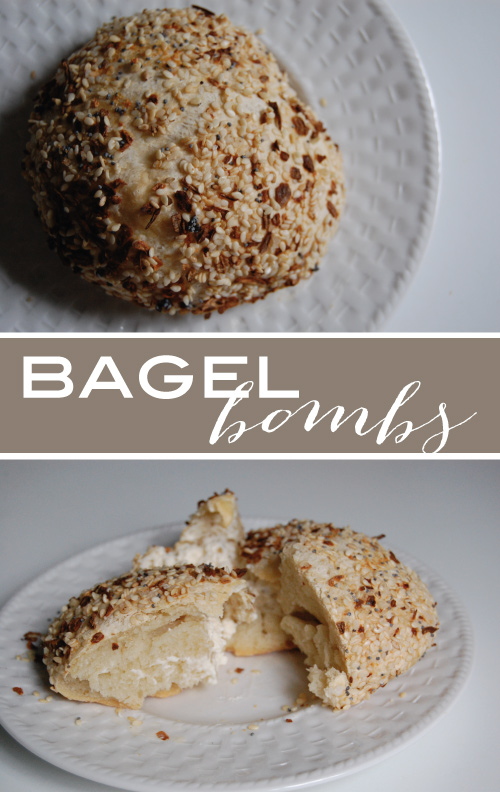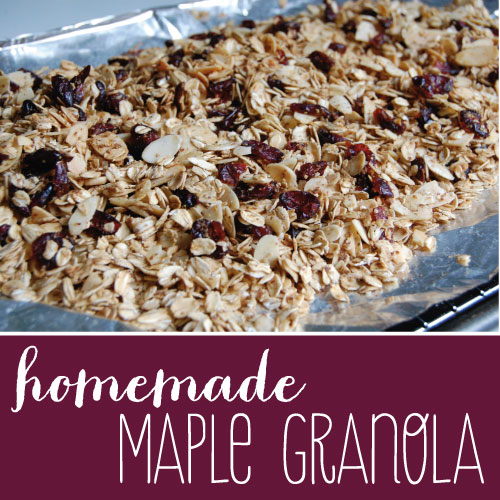 There's only one word for these suckers... obsessed! I am, my husband is, our friends are... The bagel bombs from Christina Tosi and the Momofuku Milk Bar
There's only one word for these suckers... obsessed! I am, my husband is, our friends are... The bagel bombs from Christina Tosi and the Momofuku Milk Bar are incredible. The mother dough that is the "bagel" outside is super easy to whip up in the KitchenAid and then the filling can be whatever you want it to be, though I've yet to venture far from the original of cream cheese, bacon and scallions... You can order the book on Amazon at the link above for this recipe and a ton of my other favorites (chocolate chocolate cookie, candy bar pie, the list goes on and on!)
Make it... for Breakfast!
In all the craziness that is the weeks leading up to the National Stationery Show, I feel like I barely get out the door in the morning, let alone grabbing a Greek yogurt (my fave!) from the fridge. This weekend, I took a step back and prepared some food for the week... Healthy lunches, bags of vegetables for snacks and homemade granola to top that yogurt for breakfast. Give it a go - it just might give you that boost that I find myself needing in the morning!

Homemade Maple Granola
1/4 cup vegetable oil 2/3 cup maple syrup 2 tsp almond extract 4 cups oatmeal (not the quick stuff… you want the old fashioned oats!) 1/2 cup pumpkin seeds 1/2 cup slivered almonds 1/2 cup golden raisins 1/2 cup dried cherries
Preheat oven to 350 degrees.
In a small bowl, combine the maple syrup, oil and almond extract. Mix well.
In a large bowl, combine the rest of the ingredients. Stir to combine. Drizzle syrup mixture over oat mixture until all syrup has been incorporated.
Spread out on a greased cookie sheet and bake for 7 minutes. Remove from oven and stir mixture around on cookie sheet. Return to oven for 8 minutes more or until golden brown.
Let cool and serve. (If stored in an air tight container, granola will keep for a couple of weeks.)
Enjoy!
Make-it Monday : Milkbar-Style
 Chocolate-Chocolate Cookiesby Christina Tosi
Makes 10 to 15 cookies
Chocolate-Chocolate Cookiesby Christina Tosi
Makes 10 to 15 cookies
An ode to my favorite baked good of all time, the fudgy brownie, this cookie has a healthy salt content and, to me, is perfection.
INGREDIENTS 16 tablespoons (2 sticks) butter, at room temperature 1 1/2 cups sugar 1/4 cup glucose 1 egg 1/4 teaspoon vanilla extract 2 ounces 55% chocolate, melted 1 1/4 cups flour 3/4 cup cocoa powder, preferably Valrhona 3 g baking powder 3/4 teaspoon 1.5 g baking soda 1/4 teaspoon 7 g kosher salt 1 3/4 teaspoons 1/2 recipe Chocolate Crumb (below) PREPARATION Combine the butter, sugar, and glucose in the bowl of a stand mixer fitted with the paddle attachment and cream together on medium-high for 2 to 3 minutes. Scrape down the sides of the bowl, add the egg, vanilla, and melted chocolate, and beat for 7 to 8 minutes.
Reduce the mixer speed to low and add the flour, cocoa powder, baking powder, baking soda, and salt. Mix just until the dough comes together, no longer than 1 minute. (Do not walk away from the machine during this step, or you will risk overmixing the dough.) Scrape down the sides of the bowl with a spatula.
Still on low speed, add the chocolate crumbs and mix just until incorporated, about 30 seconds.
Using a 2 3/4-ounce ice cream scoop (or a 1/3-cup measure), portion out the dough onto a parchment-lined sheet pan. Pat the tops of the cookie dough domes flat. Wrap the sheet pan tightly in plastic wrap and refrigerate for at least 1 hour, or up to 1 week. Do not bake your cookies from room temperature--they will not bake properly.
Heat the oven to 375°F.
Arrange the chilled dough a minimum of 4 inches apart on parchment- or Silpat-lined sheet pans. Bake for 18 minutes. The cookies will puff, crackle, and spread. It's tough (kind of impossible) to gauge if a cookie that is this dark with chocolate is done. If after 18 minutes, the cookies still seem doughy in the center, give them another 1 minute in the oven, but not more.
Cool the cookies completely on the sheet pans before transferring to a plate or an airtight container for storage. At room temp, the cookies will keep fresh for 5 days; in the freezer, they will keep for 1 month.
Chocolate Crumb Makes about 2 1/2 cups
INGREDIENTS 2/3 cup flour 1 teaspoon cornstarch 1/2 cup sugar 2/ 3 cup cocoa powder, preferably Valrhona 1 teaspoon kosher salt 6 tablespoons butter, melted
PREPARATION Heat the oven to 300 degrees F.
Combine the flour, cornstarch, sugar, cocoa powder, and salt in the bowl of a stand mixer fitted with the paddle attachment and paddle on low speed until mixed.
Add the butter and paddle on low speed until the mixture starts to come together in small clusters.
Spread the clusters on a parchment- or Silpat-lined sheet pan. Bake for 20 minutes, breaking them up occasionally. The crumbs should still be slightly moist to the touch at that point; they will dry and harden as they cool.
Let the crumbs cool completely before using in a recipe or eating. Stored in an airtight container, they will keep fresh for 1 week at room temperature or 1 month in the fridge or freezer.
Recipe from bonappetit.com
Homemade Croissants
We're embarking on a journey back to my favorite adventure from our winter break right after Christmas today for our Make-It Monday feature. I've always wanted to tackle homemade croissants from start to finish entirely by hand and I did just that. I'm going to warn you - it's quite a laborious task, but I think it was SO worth the efforts for the end prize (and my husband's family did too - though they didn't have to do the rolling!) Bon Appetit!


Recipe after the break...This recipe is from a 2000 issue of Gourmet Magazine...
Homemade Croissants
- 1 1/2 cups whole milk, heated to warm (105°F–110°F)
- 1/4 cup packed light brown sugar
- 1 tablespoon plus 1/4 teaspoon active dry yeast (from two 1/4-oz packages)
- 3 3/4 to 4 1/2 cups unbleached all-purpose flour
- 1 tablespoon kosher salt
- 3 sticks (1 1/2 cups) cold unsalted butter
Make dough: Stir together warm milk, brown sugar, and yeast in bowl of standing mixer and let stand until foamy, about 5 minutes. (If it doesn’t foam, discard and start over.) Add 3 3/4 cups flour and salt and mix with dough hook at low speed until dough is smooth and very soft, about 7 minutes.
Transfer dough to a work surface and knead by hand 2 minutes, adding more flour as necessary, a little at a time, to make a soft, slightly sticky dough. Form dough into a roughly 1 1/2-inch-thick rectangle and chill, wrapped in plastic wrap, until cold, about 1 hour.
Prepare and shape butter: After dough has chilled, arrange sticks of butter horizontally, their sides touching, on a work surface. Pound butter with a rolling pin to soften slightly (butter should be malleable but still cold). Scrape butter into a block and put on a kitchen towel, then cover with other towel. Pound and roll out on both sides until butter forms a uniform 8- by 5-inch rectangle. Chill, wrapped in towels, while rolling out dough.
Roll out dough: Unwrap dough and roll out on a lightly floured surface, dusting with flour as necessary and lifting and stretching dough (especially in corners), into a 16- by 10-inch rectangle. Arrange dough with a short side nearest you. Put butter in center of dough so that long sides of butter are parallel to short sides of dough. Fold as you would a letter: bottom third of dough over butter, then top third down over dough. Brush off excess flour with pastry brush.
Roll out dough: Turn dough so a short side is nearest you, then flatten dough slightly by pressing down horizontally with rolling pin across dough at regular intervals, making uniform impressions. Roll out dough into a 15- by 10-inch rectangle, rolling just to but not over ends.
Brush off any excess flour. Fold in thirds like a letter, as above, stretching corners to square off dough, forming a 10- by 5-inch rectangle. (You have completed the first "fold.") Chill, wrapped in plastic wrap, 1 hour.
Make remaining "folds": Make 3 more folds in same manner, chilling dough 1 hour after each fold, for a total of 4 folds. (If any butter oozes out while rolling, sprinkle with flour to prevent sticking.) Wrap dough tightly in plastic wrap and chill at least 8 hours but no more than 18 (after 18 hours, dough may not rise sufficiently when baked).
Roll out and cut dough: Cut dough in half and chill 1 half, wrapped in plastic wrap. Roll out other half on a lightly floured surface, dusting with flour as necessary and stretching corners to maintain shape, into a 16- by 12-inch rectangle. Brush off excess flour with pastry brush and trim edges with a pizza wheel or sharp knife.
Arrange dough with a short side nearest you. Cut in half horizontally and chill 1 half. Cut remaining half vertically into thirds, forming 3 rectangles. Cut each rectangle diagonally in half to make 2 triangles, for a total of 6 triangles.
Shape croissants: Holding short side (side opposite tip) of 1 triangle in one hand, stretch dough, tugging and sliding with other hand toward tip to elongate by about 50 percent.
Return to work surface with short side of triangle nearest you. Beginning with short side, roll up triangle toward tip. Croissant should overlap 3 times, with tip sticking out from underneath; you may need to stretch dough while rolling.)
Put croissant, tip side down, on a parchment-lined large baking sheet. (Curve ends inward to make a crescent shape if desired.)
Make more croissants with remaining 5 triangles, then with remaining rolled-out dough, arranging them 2 inches apart on baking sheet. Repeat rolling, cutting, and shaping procedures with chilled piece of dough.
Let croissants rise: Slide each baking sheet into a garbage bag, propping up top of bag with inverted glasses to keep it from touching croissants, and tuck open end under baking sheet.
Let croissants rise until slightly puffy and spongy to the touch, 2 to 2‚ hours.
Bake croissants: Adjust oven racks to upper and lower thirds of oven and preheat to 425°F.
Remove baking sheets from bags. Spritz inside oven generously with spray bottle and close door. Put croissants in oven, then spritz again before closing door. Reduce temperature to 400°F and bake 10 minutes without opening door.
Switch position of sheets in oven and rotate sheets 180°, then reduce temperature to 375°F and bake until croissants are deep golden, about 10 minutes more.
Cooks' note: •Baked and cooled croissants keep 1 month: First freeze them, uncovered, on baking sheets until firm, then wrap them snugly in foil before returning to freezer. When ready to serve, remove foil and bake (not thawed) on a baking sheet in a 325°F oven 5 to 10 minutes.
Francophiles Unite!
 Since our company's name is French, we've got a week of treats for the francophiles out there! For Make-it Monday, instead of storming a Parisian prison, storm into that kitchen and get cooking! Thursday's the day the French stormed the Bastille prison in 1789, an open act of rebellion against the monarchy that is considered a turning point of the French Revolution.
Since our company's name is French, we've got a week of treats for the francophiles out there! For Make-it Monday, instead of storming a Parisian prison, storm into that kitchen and get cooking! Thursday's the day the French stormed the Bastille prison in 1789, an open act of rebellion against the monarchy that is considered a turning point of the French Revolution.
After the Revolution, “while their former bosses were fleeing the country or losing their heads to the guillotine, chefs of the royal court found themselves out on the rue without so much as a roux to whisk,” said Carl Hanson.
Lucky for them, a promising new institution had begun popping up in Paris during the second half of the 18th century. This new-fangled thing was known as the restaurant. The first restaurants had opened in the 1760s and originally catered to those of fragile health. In fact, the word “restaurant” refers not to resting or ranting but to the “restorative” broths that were intended to return delicate Parisians and weary travelers to good health.
With the arrival of revolution, however, the restaurant became a venue for displaced chefs to practice their craft in a clean setting that, significantly, was open to all comers, not just royalty. For once, it did not require a noble pedigree to dine like a king, only sufficient funds to pay the check. And with that, the art of fine dining was born!
So, in celebration today, we made homemade croissants (the recipe is after the jump). This one if not for the faint of heart, but the results are well worth the effort! Bon appetit!
Classic French Croissants adapted from Epicurious
1 1/2 cups whole milk, heated to warm (105°F–110°F) 1/4 cup packed light brown sugar 1 tbsp plus 1/4 tsp active dry yeast 3 3/4 to 4 1/2 cups unbleached all-purpose flour 1 tablespoon kosher salt 3 sticks (1 1/2 cups) really cold unsalted butter
Start by making the dough: Stir together warm milk, brown sugar, and yeast in bowl of standing mixer and let stand until foamy, about 5 minutes. (If it doesn’t foam, discard and start over – the yeast was dead.) Add 3 3/4 cups flour and salt and mix with dough hook at low speed until dough is smooth and very soft, about 7-9 minutes.
Transfer dough to a work surface and knead by hand 2 minutes, adding more flour as necessary, a little at a time, to make a soft, slightly sticky dough. Form dough into a roughly 1 1/2-inch-thick rectangle and chill, wrapped in plastic wrap, until cold, about 1 hour.
Prepare and shape butter: After dough has chilled, arrange sticks of butter horizontally, their sides touching, on a work surface. Pound butter with a rolling pin to soften slightly (butter should be malleable but still cold). Scrape butter into a block and put on a kitchen towel (flour sack towels work best), then cover with other towel. Pound and roll out on both sides until butter forms a uniform 8- by 5-inch rectangle. Chill, wrapped in towels, while rolling out dough. (Don’t skimp on the chilling – it’s important to not let the butter “melt”)
Roll out dough: Unwrap dough and roll out on a lightly floured surface, dusting with flour as necessary and lifting and stretching dough (especially in corners), into a 16- by 10-inch rectangle. Arrange dough with a short side nearest you. Put butter in center of dough so that long sides of butter are parallel to short sides of dough. Fold as you would a letter: bottom third of dough over butter, then top third down over dough. Brush off excess flour with pastry brush.
Roll out dough: Turn dough so a short side is nearest you, then flatten dough slightly by pressing down horizontally with rolling pin across dough at regular intervals, making uniform impressions. Roll out dough into a 15- by 10-inch rectangle, rolling just to but not over ends.
Brush off any excess flour. Fold in thirds like a letter, as above, stretching corners to square off dough, forming a 10- by 5-inch rectangle. (You have completed the first “fold.”) Chill, wrapped in plastic wrap, 1 hour.
Make remaining “folds”: Make 3 more folds in same manner, chilling dough 1 hour after each fold, for a total of 4 folds. (If any butter oozes out while rolling, sprinkle with flour to prevent sticking.) Wrap dough tightly in plastic wrap and chill at least 8 hours but no more than 18 (after 18 hours, dough may not rise sufficiently when baked).
Roll out and cut dough: Cut dough in half and chill 1 half, wrapped in plastic wrap. Roll out other half on a lightly floured surface, dusting with flour as necessary and stretching corners to maintain shape, into a 16- by 12-inch rectangle. Brush off excess flour with pastry brush and trim edges with a pizza wheel or sharp knife.
Arrange dough with a short side nearest you. Cut in half horizontally and chill 1 half. Cut remaining half vertically into thirds, forming 3 rectangles. Cut each rectangle diagonally in half to make 2 triangles, for a total of 6 triangles.
Shape croissants: Holding short side (side opposite tip) of 1 triangle in one hand, stretch dough, tugging and sliding with other hand toward tip to elongate by about 50 percent.
Return to work surface with short side of triangle nearest you. Beginning with short side, roll up triangle toward tip. (Croissant should overlap 3 times, with tip sticking out from underneath; you may need to stretch dough while rolling.)
Put croissant, tip side down, on a parchment-lined large baking sheet. (Curve ends inward to make a crescent shape if desired.)
Make more croissants with remaining 5 triangles, then with remaining rolled-out dough, arranging them 2 inches apart on baking sheet. Repeat rolling, cutting, and shaping procedures with chilled piece of dough.
Let croissants rise: Slide each baking sheet into a garbage bag, propping up top of bag with inverted glasses to keep it from touching croissants, and tuck open end under baking sheet.
Let croissants rise until slightly puffy and spongy to the touch, 2 to 2 1/2 hours.
Bake croissants: Adjust oven racks to upper and lower thirds of oven and preheat to 425°F.
Remove baking sheets from bags. Spritz inside oven generously with spray bottle and close door. Put croissants in oven, then spritz again before closing door. Reduce temperature to 400°F and bake 10 minutes without opening door.
Switch position of sheets in oven and rotate sheets 180°, then reduce temperature to 375°F and bake until croissants are deep golden, about 10 minutes more.
Enjoy!!!
